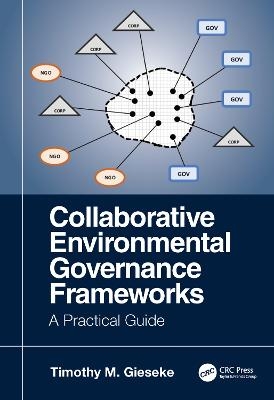
Collaborative Environmental Governance Frameworks
CRC Press (Verlag)
978-1-138-58450-1 (ISBN)
This book takes a practical approach to understanding and describing collaborative governance for resolving environmental problems. It introduces a new collaborative governance assessment model and recognizes that collaborations are a natural result of organizations converging around complex issues. Rather than identifying actors by their type of organization, the actors are identified by the type of role they play. This approach is aligned with how individuals and organizations interact in practice, and their dependance on collaborations to solve emerging environmental problems. The book discusses real cases with governance issues and creates new frameworks for collaborations.
Features:
Addresses communities at all levels and scales that are gravitating toward collaborations to solve their environmental issues.
Prepares and enables individuals to participate in collaborative governance and design collaborative governance frameworks.
Introduces the first simplified and standardized model to assess governance using governance actors and styles.
Explains governance in simple terms and builds governance frameworks from the individual’s perspective; the smallest, viable unit of governance in a collaboration.
Describes "tools of convergence" for collaborative leaders to organize and align activities to create shared-governance outcomes and outputs.
Timothy M. Gieseke’s interdisciplinary career is reflected in the research and insights of his writings. A master’s degree in environmental sciences is a cornerstone for his perspective on agriculture sustainability. He also brings experience in agriculture production, governmental experience in conservation planning, policy analysis at state and federal levels, political endeavors, and agribusiness management. With this near panoramic view of landscape sustainability, Tim recognized the need for a transdisciplinary approach to enable practitioners and policy-makers to transcend and blur the lines between their traditional organizational boundaries. He has carried this vision through several of his local to global efforts. He is the author of the book Shared Governance for Sustainable Working Landscapes published by CRC Press in 2016.
Introduction. Something Special Is Happening. Entering a Collaborative Era. Collaborations as Hybrid Organizations. Preparing to Collaborate. The Science of Collaborative Governance. Of Actors and Styles. What Style of Governance Do You "Swim In?". Governance Footprints and Frameworks. Social Complexity and Three Wicked Case Studies. Social Complexity. The Nature of Societal Problems. The Nature of Three Wicked Case Studies. Designing Collaborative Governance Frameworks. The Nature of Collaborative Governance. A Meta-Governor’s Role in Three Wicked Case Studies. Making Collaborative Governance Happen. Conclusion.
| Erscheinungsdatum | 27.08.2019 |
|---|---|
| Zusatzinfo | 5 Tables, black and white; 42 Illustrations, black and white |
| Verlagsort | London |
| Sprache | englisch |
| Maße | 156 x 234 mm |
| Gewicht | 299 g |
| Themenwelt | Naturwissenschaften ► Biologie ► Ökologie / Naturschutz |
| Naturwissenschaften ► Geowissenschaften ► Geografie / Kartografie | |
| Technik ► Umwelttechnik / Biotechnologie | |
| ISBN-10 | 1-138-58450-9 / 1138584509 |
| ISBN-13 | 978-1-138-58450-1 / 9781138584501 |
| Zustand | Neuware |
| Haben Sie eine Frage zum Produkt? |
aus dem Bereich


